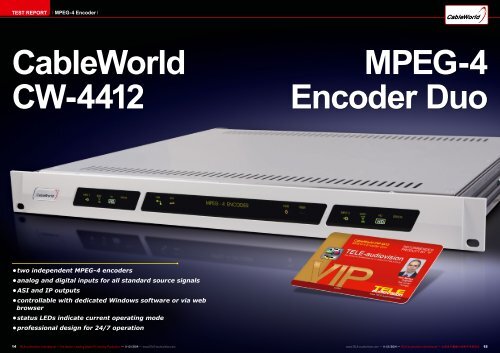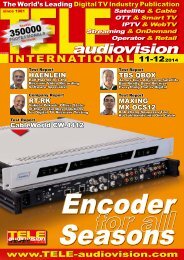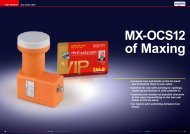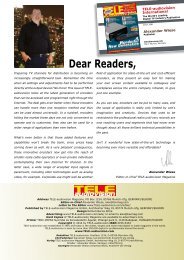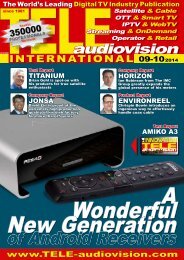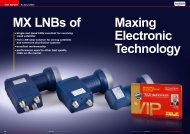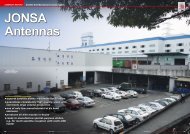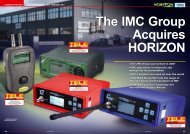CableWorld CW-4412 MPEG-4 Encoder Duo
Create successful ePaper yourself
Turn your PDF publications into a flip-book with our unique Google optimized e-Paper software.
TEST REPORT<br />
<strong>MPEG</strong>-4 <strong>Encoder</strong><br />
<strong>CableWorld</strong><br />
<strong>CW</strong>-<strong>4412</strong><br />
<strong>MPEG</strong>-4<br />
<strong>Encoder</strong> <strong>Duo</strong><br />
• two independent <strong>MPEG</strong>-4 encoders<br />
• analog and digital inputs for all standard source signals<br />
• ASI and IP outputs<br />
• controllable with dedicated Windows software or via web<br />
browser<br />
• status LEDs indicate current operating mode<br />
• professional design for 24/7 operation<br />
14 TELE-audiovision International — The World‘s Leading Digital TV Industry Publication — 11-12/2014 — www.TELE-audiovision.com<br />
www.TELE-audiovision.com — 11-12/2014 — TELE-audiovision International — 全 球 发 行 量 最 大 的 数 字 电 视 杂 志 15
TEST REPORT<br />
<strong>MPEG</strong>-4 <strong>Encoder</strong><br />
<strong>MPEG</strong>-4 Conversion<br />
in Real-time<br />
When it comes to efficient<br />
transmission of digital<br />
video signals, <strong>MPEG</strong>-4 is<br />
THE established standard<br />
these days. But then again,<br />
head-ends are still frequently<br />
faced with analog source<br />
signals or digital signals that<br />
have been compressed using<br />
<strong>MPEG</strong>-2. If those signals<br />
need to be provided in DVB-<br />
S/S2, DVB-C/C2 or DVB-T/<br />
T2 modulations, there is no<br />
way around converting them<br />
into the <strong>MPEG</strong>-4 format – in<br />
real-time!<br />
And we’re not only talking<br />
country-wide cable<br />
networks, mind you! Even<br />
small-scale applications such<br />
as a limited offering of TV<br />
channels via DVB-C or DVB-<br />
T in hotels or hospitals use<br />
<strong>MPEG</strong>-4 as state-of-the-art<br />
compression format, since it<br />
handles signals much more<br />
efficiently and therefore is<br />
able to transmit more channels<br />
with better quality on<br />
the same number of available<br />
transponders. Given this<br />
fact, it does not make sense<br />
any more to throw money after<br />
<strong>MPEG</strong>-2.<br />
While this sounds reasonable<br />
enough in theory, the<br />
real world poses a number<br />
of challenges. What if devices<br />
such as cameras or<br />
reception equipment are not<br />
yet capable of directly processing<br />
<strong>MPEG</strong>-4 signals? Of<br />
course, it’s always possible<br />
to replace existing technology<br />
with new state-of-the-art<br />
equipment, but this involves<br />
considerable amounts of<br />
money. Opting for an <strong>MPEG</strong>-<br />
4 decoder instead does away<br />
with the need for such a major<br />
investment.<br />
Or you may simply want<br />
to feed signals from <strong>MPEG</strong>-2<br />
transponders into your local<br />
<strong>MPEG</strong>-4 network. Here, too,<br />
an <strong>MPEG</strong>-4 decoder is an efficient<br />
solution.<br />
Or what if you need to distribute<br />
the content of your<br />
PC monitor to a number of<br />
workplaces in order to present<br />
animations or simulations<br />
in real-time? Once<br />
again, an <strong>MPEG</strong>-4 decoder<br />
will get you there without a<br />
lot of hassle.<br />
So here we are, presenting<br />
to you a device that will<br />
solve all those problems. It’s<br />
called <strong>CW</strong>-<strong>4412</strong> and comes<br />
from <strong>CableWorld</strong>, a company<br />
focusing on developing and<br />
manufacturing professional<br />
digital equipment such as<br />
receivers, modulators, signal<br />
meters, transport stream<br />
generators, analysers, multiplexers,<br />
converters as well<br />
as <strong>MPEG</strong> decoders and encoders.<br />
<strong>CableWorld</strong> has been<br />
in business for more than 20<br />
years now and its product<br />
portfolio has been growing<br />
impressively.<br />
<strong>CableWorld</strong> has four different<br />
<strong>MPEG</strong>-4 encoders on<br />
offer, all of which belong the<br />
same product family:<br />
<strong>CW</strong>-4411: single H.264<br />
encoder with ASI and IP outputs<br />
<strong>CW</strong>-<strong>4412</strong>: two H.264 encoders<br />
with ASI and IP outputs<br />
<strong>CW</strong>-4511: single H.264<br />
encoder with IP output<br />
<strong>CW</strong>-4512: two H.264 encoders<br />
with IP output<br />
All of these four models<br />
come with the same encoder<br />
type and an identical<br />
front-end. This makes for remarkable<br />
ease of operation<br />
since all encoders feature<br />
the same user interface. It<br />
is thus possible to obtain differently<br />
equipped encoders<br />
www.TELE-audiovision.com/14/11/cableworld<br />
11-12/2014<br />
<strong>CableWorld</strong> <strong>CW</strong>-<strong>4412</strong><br />
<strong>MPEG</strong>-4 <strong>Encoder</strong> <strong>Duo</strong><br />
Amazing results with this<br />
very easy-to-use <strong>MPEG</strong>-4 encoder<br />
16 TELE-audiovision International — The World‘s Leading Digital TV Industry Publication — 11-12/2014 — www.TELE-audiovision.com
that meet precise requirements without<br />
technicians having to familiarise themselves<br />
with new control interfaces for<br />
each device.<br />
All used encoders are compatible with<br />
H.264 (<strong>MPEG</strong>-4 Part 10 AVC according<br />
to ISO / IEC 14496-10) and can create<br />
streams with either CBR (constant bit<br />
rate) or VBR (variable bit rate), depending<br />
on the configuration of the device.<br />
<strong>MPEG</strong>-4 Part 10 can easily be called the<br />
most popular format for video compression<br />
today and has become the<br />
established standard for recording and<br />
distributing video content.<br />
For our in-depth test the <strong>CW</strong>-<strong>4412</strong><br />
variant was shipped to the TELE-audiovision<br />
Test Center. The device is packaged<br />
inside a sturdy cardboard, which<br />
makes sure it arrives at its destination<br />
in mint condition. Apart from the encoder<br />
itself and the power cable there<br />
were only two sheets of paper inside<br />
the box: One contained the operating<br />
manual in English, the other one featured<br />
instructions for the web interface.<br />
Both texts are rather concise and<br />
only provide essential steps for operation:<br />
The <strong>CW</strong>-<strong>4412</strong> can either be controlled<br />
via Windows software or directly<br />
through its web interface from any web<br />
browser. The default IP addresses for<br />
accessing the encoder are also given in<br />
the instructions.<br />
With its white rack-sized case the<br />
<strong>CW</strong>-<strong>4412</strong> looks just as unpretentious as<br />
the instruction manual: The only physical<br />
control element is an On/Off switch<br />
on the back panel of the encoder. What<br />
the back panel does feature, however,<br />
is an abundance of connection options.<br />
Owing to the fact that the <strong>CW</strong>-<strong>4412</strong> is<br />
capable of simultaneously compressing<br />
two independent input signals into the<br />
<strong>MPEG</strong>-4 format we have two connection<br />
interfaces each for SDI, component<br />
video (YUV), composite video and<br />
HDMI. As far as outputs are concerned<br />
this encoder sports a total of four ASI<br />
outputs, which means there are two<br />
ASI sockets for each of the two encoders.<br />
Two USB ports – again, one for<br />
each encoder – are available for firmware<br />
updates.<br />
Turning to the front panel, we find 10<br />
LEDs which indicate the encoders’ current<br />
operating mode. Divided into three<br />
sections, 4 LEDs on the left refer to<br />
encoder 1 (Input 1, BUSY, HD and ER-<br />
ROR), 4 LEDs on the right do the same<br />
for encoder 2, while the middle section<br />
indicates the following general states:<br />
LINK, ACT, PWR and FIBER.<br />
1<br />
With the clear labelling of those LEDs,<br />
their purpose is more or less self-explanatory:<br />
INPUT 1 and INPUT 2: These two<br />
LEDs indicate whether or not a signal is<br />
fed into the encoders.<br />
BUSY: A slowly flashing LED indicates<br />
that new firmware is being loaded.<br />
If the LED flashes in short intervals,<br />
this indicates that process parameters<br />
are loaded by the computer. In both<br />
cases the <strong>MPEG</strong>-4 compression routine<br />
is temporarily stopped. In general,<br />
however, such interruptions do not last<br />
longer than 1 or 2 seconds.<br />
HD: Lights up whenever an HD signal<br />
is available from the encoder input.<br />
ERROR: In case an error occurs during<br />
the encoding process this LED will<br />
light up. This can happen if the process<br />
SW-<strong>4412</strong><br />
1. This application allows to configure the<br />
input signal on the <strong>CW</strong>-<strong>4412</strong> encoder. You<br />
can convert high resolution signals to<br />
lower resolution signals. Also, it is possible<br />
to select if a constant bit rate (CBR) or a<br />
variable bit rate (VBR) should be used. The<br />
latter can be used to decrease the summed<br />
bit rate of a transport stream containing<br />
many channels: in average different channels<br />
rarely have high bit rate requirements<br />
in the same moment in time, which helps<br />
keeping the overall transport stream bit<br />
rate low. To use the VBR option, different<br />
interdependent parameters have to be<br />
specified. Fortunately, the <strong>CW</strong>-<strong>4412</strong> will let<br />
you know instantly if they make sense and<br />
suggest how to calculate correct values –<br />
this will help you save the time of digging<br />
out reference manuals. Another important<br />
set of configurable parameters that include<br />
the Service Provider and Service Name and<br />
the allocated Video, Audio, PMT, PCR, TS<br />
and TXT PID’s.<br />
2. Clicking on the <strong>MPEG</strong> <strong>Encoder</strong> -2 tab will<br />
simply open the exact same set of parameters<br />
for the second encoder of the <strong>CW</strong>-<strong>4412</strong>.<br />
In fact, the <strong>CW</strong>-<strong>4412</strong> acts as two independent<br />
<strong>MPEG</strong>-4 encoders, which just happen<br />
to share the same case, power supply and<br />
operational frontend.<br />
2<br />
18 TELE-audiovision International — The World‘s Leading Digital TV Industry Publication — 11-12/2014 — www.TELE-audiovision.com
5<br />
parameters are incorrect. To prevent<br />
a total failure of the compression sequence<br />
the encoder attempts an automatic<br />
reset. In actual fact, this is by<br />
far the easiest and frequently most efficient<br />
trouble shooting method available.<br />
After all, who hasn’t been asked by<br />
support staff “Have you tried turning it<br />
OFF and ON again?“ Come to think of it,<br />
why don’t all electronic devices behave<br />
like that?<br />
LINK: This LED indicates that a network<br />
cable is connected to the IP output.<br />
ACT: Each outgoing data packet<br />
prompts this LED to flash, just like with<br />
network switches.<br />
PWR: This LED becomes active as<br />
soon as the device is switched on and<br />
powered.<br />
FIBER: As soon as a fibre-optic cable<br />
is attached to the device this status<br />
LED lights up. The FIBER interface is<br />
available as an option and our test encoder<br />
was not equipped with one.<br />
The 10 LEDs do a tremendous job in<br />
always keeping you informed about the<br />
current status of the encoder. A short<br />
glimpse is all you need to find out if an<br />
error has occurred. We cannot praise<br />
this feature highly enough, because we<br />
SW-4901<br />
3. The SW-4901 software is a generic application<br />
for <strong>CableWorld</strong> devices. It can be<br />
used to configure every networking aspect<br />
of the <strong>CW</strong>-<strong>4412</strong>, including the IP streaming<br />
options. The SW-4901 application is very<br />
structured and the first tab will simply allow<br />
the user to configure the correct IP address<br />
to establish the communication link to the<br />
device. The Query button will then test if<br />
such connection has been established and<br />
lists a sum-up of the device. If you don’t<br />
remember what the correct IP address is,<br />
don’t be ashamed – it happens to all of<br />
us. <strong>CableWorld</strong> included a neat Search<br />
function, which will detect the device in the<br />
network.<br />
4. The second tab allows setting up the<br />
network: which ports are to be used for<br />
management and streaming and, of course,<br />
you can set the desired IP address of the<br />
<strong>CW</strong>-<strong>4412</strong>.<br />
5. The IP Receiver Platform tab is of no use<br />
for the <strong>CW</strong>-<strong>4412</strong> and can be ignored for this<br />
device. It allows setting up incoming IP<br />
Transport Streams.<br />
6. It is the TS Sender Platform tab, which<br />
has to be configured, in case IP output<br />
is desired on the <strong>CW</strong>-<strong>4412</strong>. Because the<br />
<strong>CW</strong>-<strong>4412</strong> has two independent encoders,<br />
the two upper groups, Transport Stream<br />
Sender 1 and 2 are to be used. Configuration<br />
is extremely self-explanatory, as all<br />
required fields are presented with corresponding<br />
names. If you want quick results,<br />
just hit the Send TS button, as all preestablished<br />
values are perfectly reasonable.<br />
You may want to change from “Send<br />
TS to Multicast” to “Send TS to IP”, in case<br />
Unicast is needed.<br />
7. The Schematic Diagram tab shows a picture<br />
explaining the common setup and the<br />
last two tabs for Special Settings and the<br />
SW-4800 Controller are best left for Cable-<br />
World engineers, in case there is a problem<br />
with the networking module.<br />
know that in most cases technicians<br />
have no end of other tasks to take care<br />
of, so they’ll appreciate that there’s no<br />
need to dig into several layers of status<br />
menus to see what’s going on. A quick<br />
look must do. And with the <strong>CW</strong>-<strong>4412</strong> it<br />
actually does.<br />
The only way to operate and control<br />
the <strong>CW</strong>-<strong>4412</strong> is from a PC, which is why<br />
we started out with visiting the manufacturer’s<br />
website at http://www.cableworld.eu<br />
to download the required software.<br />
Some may wonder why essential<br />
software is not provided on CD or DVD<br />
any longer, but these days manufacturers<br />
can reasonably assume that buyers<br />
of their products have Internet access,<br />
and this way the latest software release<br />
can be made available at any point in<br />
time. If our opinion is anything to go by,<br />
3<br />
4<br />
that’s the only way to go in this day and<br />
age. But we digress…<br />
In our case it was not even necessary<br />
to download new software, since the<br />
test unit came with the latest firmware<br />
release which cannot only be controlled<br />
with specially developed PC software<br />
but also through the newly integrated<br />
web interface, which can be accessed<br />
from any standard web browser. We<br />
tried out Internet Explorer, Firefox and<br />
Chrome and found no fault with any<br />
of them. All can be used to set up and<br />
control the <strong>CW</strong>-<strong>4412</strong> as required.<br />
There’s only one little downer that we<br />
should not keep secret: Current smartphones<br />
and tablets cannot be used<br />
to control the <strong>CW</strong>-<strong>4412</strong> because Java<br />
Runtime – which would be essential for<br />
that – is lacking. In addition, the imple-<br />
mented Java application is not signed.<br />
Of course this did not keep up us from<br />
giving the encoder a quick try right<br />
away. We simply connected an Xbox<br />
360 to the <strong>CW</strong>-<strong>4412</strong> via HDMI and distributed<br />
the encoded stream via multiplex<br />
on our local network. Did it work?<br />
Just like that? It actually did, and we<br />
could flawlessly receive and process<br />
the stream with the TSReader and VLC<br />
applications. Our first conclusion: Using<br />
the <strong>CW</strong>-<strong>4412</strong> is child’s play and selfexplanatory.<br />
Encouraged by this initial success we<br />
went about experimenting with different<br />
bit rate settings in order to evaluate<br />
their impact on the video quality.<br />
Then we proceeded with feeding a<br />
number of different signals to the <strong>CW</strong>-<br />
<strong>4412</strong>, ranging from analog camcorder<br />
to rarely used HDMI resolutions, only<br />
to find out that the encoder willingly<br />
accepted and processed anything we<br />
threw at it. To honest, this device was a<br />
challenge for the TELE-audiovision test<br />
team, not the other way round. It simply<br />
works flawlessly, does exactly what<br />
you want it to do and, in addition, is extremely<br />
easy to operate. Others might<br />
have decided to cut short the test and<br />
go for a coffee – but not us!<br />
We looked at all features and options<br />
and fed any type of source signal we<br />
could find or create. The range of settings<br />
for creating an <strong>MPEG</strong>-4 stream<br />
that meets bespoke requirements is impressive;<br />
there’s simply no better word<br />
for it. What’s more, the <strong>CW</strong>-<strong>4412</strong> reacts<br />
to all commands and adjustments<br />
with breath-taking speed. You change<br />
a parameter and the next second the<br />
created <strong>MPEG</strong>-4 stream reflects that<br />
change. This gives technician the option<br />
of making adjustments on-the-fly,<br />
and all that viewers will notice is a very<br />
short signal interruption.<br />
CBR & VBR<br />
Depending on area of application and<br />
available bandwidth, the <strong>CW</strong>-<strong>4412</strong> can<br />
create an encoded stream with either<br />
constant bit rate (CBR) or variable bit<br />
rate (VBR). With CBR the encoder will<br />
compress the signal more or less highly<br />
in order to constantly reach the pre-defined<br />
target bit rate. This means a sequence<br />
with little changes in the video<br />
will be subject to hardly any compression,<br />
while sudden changes in the video<br />
(such as movements or new objects)<br />
will require high compression in order<br />
not to exceed the target bit rate.<br />
What are the benefits and drawbacks<br />
of CBR? For one thing, it is much easier<br />
to calculate the required bandwidth or<br />
overall bit rate of a transponder if it carries<br />
CBR signals, for obvious reasons.<br />
In addition, virtually all receivers can<br />
handle CBR signals. But where there’s<br />
6<br />
7<br />
20 TELE-audiovision International — The World‘s Leading Digital TV Industry Publication — 11-12/2014 — www.TELE-audiovision.com<br />
www.TELE-audiovision.com — 11-12/2014 — TELE-audiovision International — 全 球 发 行 量 最 大 的 数 字 电 视 杂 志 21
8<br />
9<br />
Web Frontend<br />
8. The web frontend on the <strong>CW</strong>-<strong>4412</strong> is based on Java. This has the<br />
advantage of a quick and user friendly interface, but comes with a<br />
price to pay: you need to authorize the IP address of the <strong>CW</strong>-<strong>4412</strong> in<br />
the exception site list, otherwise the recommended security settings<br />
11<br />
12<br />
will obviously block the execution. Unfortunately, the fact that the web<br />
frontend relies on Java means that common Android or iOS devices<br />
cannot be used to configure the <strong>CW</strong>-<strong>4412</strong>.<br />
9. START – WELCOME: A welcome screen is always nice. <strong>CableWorld</strong><br />
uses this space to give a description of the device. This may seem<br />
unnecessary, but in a crowed head-end with lots of different devices<br />
you will quickly benefit from getting such a welcome screen, since you<br />
will immediately know, which device you just connected to.<br />
10. START – QUICK SETUP:Here you can set up all relevant parameters<br />
in three tabs, which correspond to the <strong>CW</strong>-4112’s block diagram: it is<br />
composed of a LAN interface and two separate encoders. The only<br />
possible confusion should be avoided at this point: the LAN Settings<br />
refer to the IPTV output settings, not the IP of the web-frontend.<br />
11. The quick setup screen for encoder 1. Here you can specify the<br />
input source and input format, as well as the output format. Notice that<br />
the <strong>CW</strong>-<strong>4412</strong> can down-convert a resolution, but obviously it cannot<br />
up-convert a low resolution to a higher one: just use a high enough<br />
bandwidth for best image quality and you make viewers happy.<br />
12. The setup screen of encoder 2 is naturally exactly the same as the<br />
previous, as both encoders have equal characteristics. Notice that the<br />
web-frontend will indicate if an input signal is preset, if the encoder is<br />
doing its job and if IP streaming is activated.<br />
13. START – SUMMARY: These pages give you a full insight on the <strong>CW</strong>-<br />
<strong>4412</strong>’s configuration and status. Organized in several tabs, the first one<br />
gives all information relative to the network configuration.<br />
14. Next is the tab of the first encoder. Check marks tell immediately if<br />
everything is OK.<br />
15. This tab shows information regarding the network output of encoder<br />
1. Notice the first line in the picture: in this case, the encoder was<br />
not configured to output anything over the network. Also, you can see<br />
that the configured mode was Multicast, rather than Unicast.<br />
16. The information tab of the second encoder, everything was OK.<br />
17. But I also had not activated the streaming output over the network,<br />
when this picture was taken.<br />
14<br />
18. ENCODER – INPUT SETUP: Two tabs allow the independent configuration<br />
of each encoder. Just tell what signal input should be used and<br />
if you require to down-convert a resolution, you can configure that too:<br />
imagine you want to read a Full HD resolution on the HDMI input, but<br />
only generate a <strong>MPEG</strong>-4 stream with a SD resolution: no problem for the<br />
<strong>CW</strong>-<strong>4412</strong>.<br />
16<br />
17<br />
10<br />
13<br />
15<br />
18<br />
22 TELE-audiovision International — The World‘s Leading Digital TV Industry Publication — 11-12/2014 — www.TELE-audiovision.com<br />
www.TELE-audiovision.com — 11-12/2014 — TELE-audiovision International — 全 球 发 行 量 最 大 的 数 字 电 视 杂 志 23
light, there’s also shadow,<br />
and in the case of CBR easy<br />
calculation comes at the<br />
expense of changing video<br />
quality. The bit rate requirements<br />
of fast camera movements<br />
or dynamic video content<br />
may easily exceed the<br />
pre-set constant bitrate (unless<br />
it equals the maximum<br />
bit rate, which generally<br />
is not the case and would<br />
waste valuable resources<br />
whenever more static content<br />
is transmitted), causing<br />
the dreaded block artefacts<br />
none of us likes to see.<br />
This is where VBR kicks<br />
in: Whenever video content<br />
does not change much, the<br />
required bit rate decreases<br />
because only few image details<br />
need to be compressed.<br />
And when all of a sudden dynamic<br />
changes in the video<br />
content occur the bit rate increases<br />
alongside so that the<br />
intended video quality after<br />
compression can be maintained.<br />
On average, the bit<br />
rate with VBR is lower than<br />
with CBR.<br />
And there’s another benefit<br />
with VBR: The chance<br />
that several variable bit<br />
rates within a single transport<br />
stream all peak at the<br />
very same time is rather low,<br />
which means that the overall<br />
bandwidth of a transponder’s<br />
transport stream with<br />
VBR signals can be smaller,<br />
while the video quality of the<br />
individual signals is higher.<br />
Sounds perfect, right? Yes,<br />
in theory. In the real world,<br />
however, VBR comes with<br />
some strings attached. For<br />
example, the encoder has<br />
to know the low and high<br />
bit rate limits that must not<br />
be exceeded. Those limits,<br />
however, depend entirely<br />
on the average bit rate. This<br />
means the encoder must analyse<br />
the video signal based<br />
Web Frontend<br />
19. ENCODER – VIDEO & AUDIO SETUP: This menu option allows<br />
to independently configure the output signal. You can select between<br />
a constant bitrate (CBR) or a variable bitrate (VBR). Also, you<br />
can change other relevant <strong>MPEG</strong>-4 parameters.<br />
20. ENCODER – MULTIPLEX SETUP: Here you can select the<br />
required PIDs for the output stream. This comes very handy, as<br />
you can avoid problems with multiplexers, if you configure the<br />
PIDs correctly at this stage. Being able to input the desired service<br />
name and service provider name is just perfect.<br />
19<br />
21. IP STREAMER – IP STREAMER SETUP: Next you can configure<br />
the IP streaming, again independently for each encoder. Just select<br />
the mode (Multicast or Unicast) and specify the relevant IP and port<br />
and you are set.<br />
22. SETTINGS – WEB INTERFACE SETTINGS: This option lets you<br />
configure the network settings for the web interface. The <strong>CW</strong>-<strong>4412</strong><br />
can be controlled through a browser or by means of free applications<br />
provided by <strong>CableWorld</strong>. Both use independent networking<br />
configurations, which is actually very convenient. If you cannot<br />
access one network, for whatever reason, you can still communicate<br />
with the <strong>CW</strong>-<strong>4412</strong> through the alternative way.<br />
21<br />
20<br />
22<br />
24 TELE-audiovision International — The World‘s Leading Digital TV Industry Publication — 11-12/2014 — www.TELE-audiovision.com
23<br />
24<br />
25<br />
on these parameters and then compress the signal accordingly.<br />
This is a hugely complex process, and the fact that it<br />
frequently has to happen in real-time doesn’t help either.<br />
<strong>CableWorld</strong> does a great job for easing that situation: For<br />
one thing, the <strong>CW</strong>-<strong>4412</strong> does not accept incorrect or impossible<br />
parameters in the first place. And for another, it shows<br />
the formulae required to calculate meaningful parameters:<br />
video bit rate >= max. video bit rate<br />
video bit rate >= avg. video bit rate<br />
1.5 x avg. video bit rate = max. video bit rate<br />
0 < min. video bit rate
lows technicians to intervene<br />
whenever it is necessary to<br />
adjust the bit rate to specific<br />
or unexpected scenarios –<br />
even right in the middle of<br />
a broadcast. Thumbs up for<br />
that!<br />
Latency<br />
If an <strong>MPEG</strong> encoder is used<br />
for continuous operation to<br />
process a signal in real-time<br />
the achieved video quality is<br />
one deciding factor, but the<br />
other major aspect is the<br />
time delay that is caused by<br />
the compression process.<br />
It goes without saying that<br />
29<br />
32<br />
35<br />
Advanced Settings<br />
28. To configure the encoder, you start by selecting the correct<br />
input source. Sources with embedded audio can be configured<br />
to use an alternative analog audio source, which can make life a<br />
lot easier. Small features like this make the <strong>CW</strong>-<strong>4412</strong> a joy to work<br />
with.<br />
29. In order to avoid any mistake or problem, you should manually<br />
specify the input format. I would not want to trust an automatic<br />
format recognition – problems could arise when you least expect<br />
them.<br />
30. Depending on the selected input format, you can toggle between<br />
different output formats. The rule is simple: you can down<br />
convert a resolution, but you cannot upscale, which would require<br />
completely different hardware and has dubious results, anyway.<br />
But the fact that the <strong>CW</strong>-<strong>4412</strong> is able to down convert, makes all<br />
the difference: how else would you handle for instance an HDMI<br />
video signal in Full HD from a PC, which is to be broadcasted as a<br />
SD channel?<br />
31. Though <strong>MPEG</strong>-4 Part 10 is an established format, which should<br />
be supported by any decoder, it is sometimes necessary to fine<br />
tune the video GOP structure, video profile and video level to<br />
obtain best results for certain <strong>MPEG</strong>-4 decoder chipsets. Again,<br />
<strong>CableWorld</strong> did not make any compromise and allows these configurations<br />
to match the installed receiver platform. This makes the<br />
<strong>CW</strong>-<strong>4412</strong> a versatile professional equipment.<br />
32. Audio is naturally compressed according to <strong>MPEG</strong>-1 Layer<br />
2 and as expected the <strong>CW</strong>-<strong>4412</strong> allows a wide selection of all<br />
common audio bitrates. It also supports AAC.<br />
33. Now here is another amazing feature: if you are using the SDI<br />
video input with separate analog audio input, then you can adjust<br />
the audio volume – separately for the left and right audio channel.<br />
34. Setting up the IP streaming functionality offers the complete<br />
range of modes: Broadcast, Unicast and Multicast. Additionally,<br />
you can select the stream to a specific MAC address.<br />
35. No compromise in the UDP payload format: all options are<br />
available.<br />
36. And you can configure the UDP payload size to your exact<br />
requirement.<br />
37. You want to spend your time with other tasks and therefore you<br />
would like to receive an automatic e-mail from the <strong>CW</strong>-<strong>4412</strong> in case<br />
something happens? No problem - just setup the relevant data.<br />
30<br />
33<br />
36<br />
28<br />
31<br />
34<br />
37<br />
28 TELE-audiovision International — The World‘s Leading Digital TV Industry Publication — 11-12/2014 — www.TELE-audiovision.com<br />
www.TELE-audiovision.com — 11-12/2014 — TELE-audiovision International — 全 球 发 行 量 最 大 的 数 字 电 视 杂 志 29
compressing a video and audio signal<br />
and then converting it into a transport<br />
stream that is finally provided through<br />
the encoder’s ASI output or via IPTV<br />
takes a little time. For pre-recorded<br />
transmissions that can be prepared in<br />
<strong>MPEG</strong>-4 beforehand this is not much<br />
of an issue, but what about time-critical<br />
transmissions such as the current<br />
time that is shown before the evening<br />
news begins, or live broadcasts? Here,<br />
a delay of a few seconds makes a lot<br />
of difference. Just think of it: Both you<br />
and your neighbour are watching a soccer<br />
match. Your neighbour is still on<br />
analog cable and whenever the team<br />
he supports scores a goal you hear him<br />
scream out while your DVB-C receiver<br />
still only shows the ball being passed<br />
from centre forward to forward. Takes<br />
a lot of fun out of the match, doesn’t it?<br />
We created the following test environment<br />
to measure the latency caused by<br />
the <strong>CW</strong>-<strong>4412</strong>: A test PC with two video<br />
outputs plays back a test pattern with<br />
an exact timer (30 frames per second).<br />
One output is connected to a standard<br />
monitor, while the second output is led<br />
to one of the two HDMI inputs of the <strong>CW</strong>-<br />
<strong>4412</strong>. We chose 1280 x 720 pixels as test<br />
resolution to tread on a middle course<br />
between 1080p and SD, which seemed<br />
reasonable and economical to us.<br />
Next, we connected one of our reference<br />
signal meters to the <strong>CW</strong>-<strong>4412</strong>’s<br />
ASI output, while a second reference<br />
meter with integrated IPTV analyser<br />
was used to also receive and look at the<br />
IPTV transport stream simultaneously.<br />
The result was genuinely breathtaking:<br />
The <strong>CW</strong>-<strong>4412</strong> provided the compressed<br />
<strong>MPEG</strong>-4 transport stream<br />
through its ASI output less than one<br />
second after the source signal had been<br />
fed to the encoder. What a treat! What’s<br />
more, the measured delay already includes<br />
the time required by the meter<br />
to demodulate and process the transport<br />
stream, which adds even more<br />
shine to the <strong>CW</strong>-<strong>4412</strong>’s performance.<br />
As far as IPTV is concerned, we<br />
measured a delay of approximately four<br />
seconds. Keep in mind, though, that<br />
this is by no means the encoder’s fault<br />
but lies in the nature of using a physi-<br />
38<br />
39<br />
40<br />
SW-4811<br />
38. <strong>CableWorld</strong> offers a free Transport<br />
Stream Analyzer software! Yes, you did<br />
read it correctly: the software is free and<br />
does not require any <strong>CableWorld</strong> specific<br />
hardware. Visit the <strong>CableWorld</strong> website<br />
right now!<br />
39. As usual with <strong>CableWorld</strong> software the<br />
application is very structured and organized<br />
in several tabs. The first tab allows<br />
to select the IP address of the multicast<br />
source.<br />
40. The Data Analyzer tab. If you can read<br />
and understand the contents of plain<br />
packets, this is for you.<br />
30 TELE-audiovision International — The World‘s Leading Digital TV Industry Publication — 11-12/2014 — www.TELE-audiovision.com
41<br />
SW-4811<br />
41. Perhaps more interesting is the Packet<br />
Analyzer tab, showing a graph that relates<br />
the data rate with time.<br />
42. The PMT Analyzer tab shows the complete<br />
PMT tree with all relevant information.<br />
43. Next comes the PSI Analyzer, showing<br />
the program specific information.<br />
cal network for distribution.<br />
Overall, we never expected<br />
latency to be so low.<br />
Compatibility<br />
of the<br />
<strong>MPEG</strong>-4 encoder<br />
We found out so far that<br />
the <strong>CW</strong>-<strong>4412</strong> did an excellent<br />
job with whatever task we<br />
demanded from it. But how<br />
about devices on the receiving<br />
end of created <strong>MPEG</strong>-4<br />
Part 10 transport streams?<br />
Would they just as happily<br />
accept the signals provided<br />
by the encoder? There’s only<br />
one way to find out – giving<br />
it a try! To that end, we<br />
modulated the transport<br />
stream provided through<br />
the ASI output into various<br />
signal types: DVB-T, DVB-C<br />
and DVB-S2. Then we took<br />
standard consumer receivers<br />
to process those signals.<br />
All receivers we tested<br />
processed and presented the<br />
<strong>MPEG</strong>-4 Part 10 transport<br />
stream created by the <strong>CW</strong>-<br />
<strong>4412</strong> with almost the same<br />
42<br />
■<br />
Testing latency: the computer<br />
monitor in the back shows the original<br />
image, the DEVISER S7000 analyzer<br />
on the left shows the compressed<br />
video received through the IP stream<br />
and the meter on the right shows the<br />
same stream received through the<br />
ASI port. Latency on ASI is extremely<br />
low and the higher latency of the IP<br />
stream is not the <strong>CW</strong>-<strong>4412</strong>’s fault: it is<br />
actually the time it takes transcoding<br />
the stream back and forth to IP. Even<br />
the ASI stream takes a short while<br />
to be decompressed and rendered<br />
on screen. I was impressed with the<br />
fantastic low latency of the <strong>CW</strong>-<strong>4412</strong>.<br />
43<br />
32 TELE-audiovision International — The World‘s Leading Digital TV Industry Publication — 11-12/2014 — www.TELE-audiovision.com<br />
www.TELE-audiovision.com — 11-12/2014 — TELE-audiovision International — 全 球 发 行 量 最 大 的 数 字 电 视 杂 志 33
44<br />
video quality than the video signal prior<br />
to <strong>MPEG</strong>-4 compression. DVB-T, DVB-C<br />
or DVB-S2 receiver – you name it. Playback<br />
without artefacts or interruption<br />
was a given at all times.<br />
Conclusion<br />
The <strong>CW</strong>-<strong>4412</strong> always does exactly<br />
what it is supposed to: It compresses<br />
different video and audio signals from<br />
various inputs (composite video, component<br />
video, SDI und HDMI) to the<br />
two discrete encoders and creates an<br />
<strong>MPEG</strong>-4 Part 10 transport stream. All<br />
this is done in real-time without significant<br />
latency. The compressed transport<br />
stream is made available via ASI and<br />
IPTV at the same time.<br />
We put the encoder to the acid test<br />
over a course of six weeks and even<br />
though we never spare time or effort,<br />
we could not prompt the <strong>CW</strong>-<strong>4412</strong> into<br />
any faulty behaviour. If power supply<br />
is interrupted the device gets back to<br />
business in less than three seconds and<br />
with all previously set parameters still<br />
in place. Manual intervention is not required.<br />
The user interface is self-explanatory<br />
and can be accessed from any web<br />
browser. This way the <strong>CW</strong>-<strong>4412</strong> is very<br />
easy to set up and control. The new<br />
web-based front-end does not only allow<br />
access from different operating<br />
system, it also adds a high level of userfriendliness<br />
to the whole process.<br />
Added to that are a lot of small tricks<br />
and treats such as tailoring the <strong>MPEG</strong>-4<br />
format right down to the last detail, or<br />
triggering an e-mail alert in case something<br />
goes wrong.<br />
We can wholeheartedly recommend<br />
the <strong>CW</strong>-<strong>4412</strong>. <strong>CableWorld</strong> has truly<br />
whizzed up a remarkable treat. Whenever<br />
real-time video compression into<br />
<strong>MPEG</strong> is the order of the day, the <strong>CW</strong>-<br />
<strong>4412</strong> (or any other member of the <strong>CW</strong>-<br />
4XXX family for that matter) is the encoder<br />
of choice.<br />
Great to know: Even if you don’t (yet)<br />
own a <strong>CableWorld</strong> product, it’s still a<br />
smart idea to download the TS Analyser<br />
SW-4811B application. It doesn’t<br />
cost a thing, yet is priceless when it<br />
comes to thoroughly analysing transport<br />
streams.<br />
SW-4811<br />
44. The Visual Tester tab will render the<br />
actual video and audio. In case of <strong>MPEG</strong>-4<br />
you need to provide your own CODEC,<br />
though. Here I was testing the <strong>MPEG</strong>-4<br />
output of the <strong>CW</strong>-<strong>4412</strong> which was fed with<br />
the composite video signal of a professional<br />
<strong>MPEG</strong>-2 IRD.<br />
45. The SW-4811 application includes a TS<br />
Recorder and TS Player tab, allowing to<br />
record and manage Transport Streams.<br />
46. Finally, the Real Time tab allows to<br />
render a graph relating the bit rates of the<br />
streams over time.<br />
45<br />
46<br />
34 TELE-audiovision International — The World‘s Leading Digital TV Industry Publication — 11-12/2014 — www.TELE-audiovision.com
50<br />
<strong>MPEG</strong>-4 Analysis<br />
47<br />
47. To analyze the resulting<br />
<strong>MPEG</strong>-4 signal I hooked up an<br />
Xbox 360 console using the<br />
HDMI connector and started<br />
my favorite game. VLC was<br />
used to get a first idea of the<br />
image quality and to know more<br />
about the used video and audio<br />
CODECs. As can be seen on the<br />
picture, the <strong>CW</strong>-<strong>4412</strong> produces<br />
a perfectly regular H264 –<br />
<strong>MPEG</strong>-4 AVC (part 10) stream.<br />
48. Trying to understand the<br />
consequences of the bitrate<br />
upon the video quality, I selected<br />
a scene in the game and<br />
toggled the bitrate. Here is the<br />
maximum picture quality, using<br />
a whopping 24000 kbps. Even<br />
with a big zoom on the plant<br />
there are virtually no visible<br />
artefacts.<br />
49. Now the same scene with<br />
the lowest recommended<br />
bitrate for a Full HD stream:<br />
6000 kbps. If you look closely,<br />
you will notice some artefacts,<br />
mainly around edges with high<br />
contrast. But still, the image<br />
quality is fabulous – much<br />
better than <strong>MPEG</strong>-2 using the<br />
same bitrate.<br />
50. What can be achieved with<br />
variable bitrate (VBR)? These<br />
pictures use an average bit rate<br />
of just 4000 kbps. However, the<br />
video quality is practically as<br />
good as the previous pictures<br />
using a constant bitrate (CBR)<br />
of 6000 kbps. Yet, this means a<br />
25% saving on the bandwidth<br />
and it was no rocket science to<br />
set it up correctly, either. Where<br />
is your excuse to use VBR?<br />
51. Next I wanted to know how<br />
well the <strong>CW</strong>-<strong>4412</strong> manages to<br />
maintain the specified bitrate.<br />
Here we see the <strong>CW</strong>-<strong>4412</strong><br />
working in VBR mode. From the<br />
graph it is easy to spot that the<br />
encoder could easily maintain<br />
the minimum bit rate of just<br />
4000 kbps, having to increase<br />
the bandwidth only when<br />
required.<br />
52. Operating the <strong>CW</strong>-<strong>4412</strong> in<br />
CBR mode at a bit rate of 6000<br />
kbps. The video bitrate is not<br />
100% constant, but the variation<br />
is relatively small.<br />
53. The same at the maximum<br />
bitrate of 24000kbps. No matter<br />
what was happening on the<br />
Xbox 360 game, the graph was<br />
steady.<br />
51<br />
52<br />
48<br />
53<br />
49<br />
36 TELE-audiovision International — The World‘s Leading Digital TV Industry Publication — 11-12/2014 — www.TELE-audiovision.com<br />
www.TELE-audiovision.com — 11-12/2014 — TELE-audiovision International — 全 球 发 行 量 最 大 的 数 字 电 视 杂 志 37
54 57<br />
60<br />
58<br />
expert<br />
OPINION<br />
<strong>CableWorld</strong> <strong>CW</strong>-<strong>4412</strong><br />
<strong>MPEG</strong>-4 <strong>Encoder</strong> <strong>Duo</strong><br />
RECOMMENDED<br />
PRODUCT BY<br />
Vitor Martins<br />
Augusto<br />
Test Center<br />
Portugal<br />
55<br />
56<br />
59<br />
+ ● Simple to use device<br />
● Made for 24/7 usage<br />
● Very low latency<br />
● Fully compatible H-264/<strong>MPEG</strong>-4 Part 10 AVC compression<br />
with many configurable parameters<br />
● Can downconvert HD to SD<br />
● ASI and IP output<br />
● Controlled comfortably through PC software or web-frontend<br />
– ● Web-Frontend relies on JAVA, hence tablets or smartphones<br />
are not supported<br />
<strong>MPEG</strong>-4 Analysis<br />
54. Analyzing the stream with Elecard’s<br />
StreamEye application revealed a perfect<br />
<strong>MPEG</strong>-4 compression without any errors.<br />
55. The resulting <strong>MPEG</strong>-4 stream was<br />
modulated to DVB-S2, DVB-C and DVB-T to<br />
test the compatibility with several receivers.<br />
In this case an older AZBox UltraHD<br />
had no problem recognizing the transponder.<br />
56. The Service Name and Service Provider<br />
Name were configured on the <strong>CW</strong>-<strong>4412</strong> and<br />
correctly displayed by the receiver. The<br />
<strong>MPEG</strong>4 stream was correctly reproduced.<br />
Just perfect.<br />
57. The same stream, in this case modulated<br />
as a DVB-T signal and received by one of<br />
the two DVB-T receivers.<br />
58. Picture was perfect for the specified SD<br />
resolution and relatively low bitrate. The<br />
receiver had no problem reproducing the<br />
stream.<br />
59. A second DVB-T receiver recognized the<br />
Service Name as well.<br />
60. …and had no trouble rendering the<br />
<strong>MPEG</strong>-4 stream.<br />
38 TELE-audiovision International — The World‘s Leading Digital TV Industry Publication — 11-12/2014 — www.TELE-audiovision.com<br />
www.TELE-audiovision.com — 11-12/2014 — TELE-audiovision International — 全 球 发 行 量 最 大 的 数 字 电 视 杂 志 39


